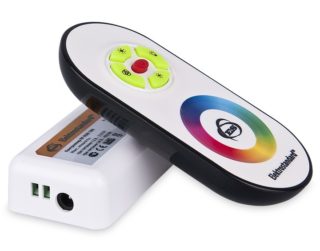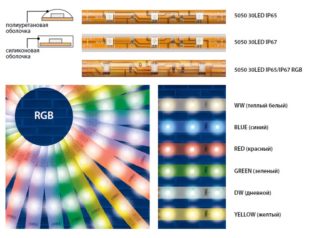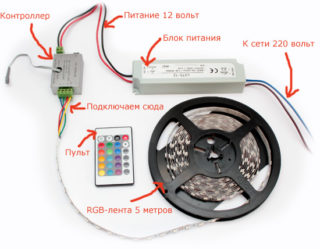For correct operation, the LED strip must be additionally connected to a special controller. A controller for LEDs is required so that the brightness and shade of the available colors of the LED strip can be adjusted from the remote control. As a rule, such structures are installed in cars, since they resemble neon.
What is RGB controller for LED strip, working principle

First of all, you need to figure out what an LED strip is. It is a flat plastic dielectric of a certain length. One side of the canvas is equipped with LEDs, and on the other, a layer of glue is applied and covered with a protective film, the latter is removed immediately before applying the tape to the surface. Most often in hardware stores there are lighting fixtures 5 meters long, but if necessary, the tape can be cut into pieces at least 2 mm long.
Each track of such a tape works independently, but at the same time it emits only one color. The change in the spectrum, as well as the brightness, occurs due to joint work with the controller. This additional control is usually sold as a kit.
The side of the tape, to which the power supply is connected, is usually equipped with additionally soldered leads - wires of different colors. Black is always a zero conductor, and red is a signal or phase conductor. If we are talking about a colored tape, the supply wires are already twice as large - black, green, blue and red. If, when connecting, you accidentally swap the signal wires in the tape, nothing terrible will happen, just the remote control will not switch colors correctly. If you confuse the signal wire with the neutral wire, you can burn the tape. On the opposite side of the tape, all tracks are connected by soldering.
As a rule, the light source of each color is grouped in 6 or 12 pieces. This design principle allows the tape to be cut to the required length.
Why do you need a controller for an LED strip

To control a single-color LED strip, a controller is not required, it is enough to connect it to a power supply, which is most often equipped with the DC12V marking for 12-volt models, if the strip has other technical characteristics, it is additionally required to select the appropriate power supply.
The most common modifications are 12-24 V, specimens requiring more voltage are rare. There are also LED strips that are directly connected to a 220 V network, but they are not available in the RGB version.
The main task of the controller is to switch circuits from the source of electricity to the end consumer. The tape is equipped with three rows of LEDs, each of which is different in color, or all three colors are made in the form of a crystal, for example, type 5050.
There are sealed controllers, they must necessarily indicate the degree of protection against moisture and dust IP.
- IP20 - delicate tapes that cannot be mounted on streets and in rooms with high levels of humidity.
- IP68 is one of the most reliable types of protection, can be used outdoors and in humid, dusty environments.
Often, manufacturers simply record the "Waterproof" mark on the case, which indicates that the tape is waterproof.
Controller types

LED canvas controllers can be used for both multi-color and monochrome varieties. The main technical characteristics, like any other electrical device, are operating voltage and power. They must necessarily correspond to the parameters of the LED strip. Power is allowed to be taken with a margin, so that after a short period of time the control unit does not fail, does not burn out.
Controllers are divided into several types depending on the method of lighting control:
- mechanical;
- sensory;
- infrared;
- radio waves.
With a mechanical method of control, a remote control is not included in the kit. You can adjust the fading speed of one color and the fading of another, the brightness of the glow can be using an ordinary button. This device is the simplest in its implementation, equipped with the minimum number of programs.
Touch-based operation also implies the absence of a control panel. Lighting control occurs by touching a sensitive panel, which is built into the wall. In this case, the technical device has a large number of possibilities, for example, full control over the lighting - the predominance of colors, their transitions and brightness.
To work with the infrared controller, it is important that it is always in the field of view of the control panel. The principle of operation is similar to the operation of a PU from a TV or other household appliances. The action of infrared waves extends up to 10 meters.
Radio wave control sends signals to the control unit even in the presence of obstacles and distances, for example, from an adjacent room with a closed door. The radius of action ranges from 20-30 meters. Each radio remote control operates exclusively at its own frequency, therefore, if it is lost, it will not be possible to purchase the same, the only way out is to completely reinstall the controller.
A common model of a radio-controlled device is a WI-FI controller; you can also connect to it using a mobile device and a tablet.
Connecting the device

After purchasing an LED strip, you need to familiarize yourself with the necessary tools and materials, as well as the connection features.
Materials required:
- A transformer, also known as a power supply.
- RGB controller.
- LED strip of the required length.
- RGB amplifier (required provided that the controller has insufficient power).
Connection is carried out using connectors for installing RGB tape, therefore, in comparison with soldering, this method is faster and more convenient. To increase the length, it is required to put on the connector at the end of the tape according to the chains.
The multicolor LED strip uses a common plus for power supply, and control is provided by the minus bus. RGB requires a four-wire connector for performance and correct operation.
The controller can also be multi-zone, which allows it to control several zones simultaneously and independently of each other.








